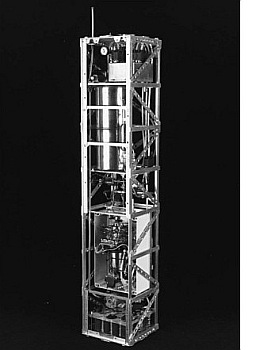Purpose of the flight and payload description
DESCARTES is the acronym of Détermination Et Séparation par Chromatographie lors de l'Analyse des Résultats des Traceurs Échantillonés dans la Stratosphère (Determination and separation by chromatography in the analysis of tracer results sampled in the Stratosphere). It is an instrument developed by the University of Cambridge for the measurement of long-lived trace gases (CFC-11, CFC-113, CCl4 and CH3CCl3) in the stratosphere. The low weight of less than 20 kg and no need of telemetry make the instrument suitable for being launched on small balloons or fly as piggyback on larger balloons.
The working principle is to let an amount of air pass through 16 sample tubes containing a Carboxen adsorbent. A valve allows only one tube at a time to be exposed to the air flow. Trace gases will then be trapped inside the sample tubes while the rest passes through. An on-board computer controls the sampling sequence, and also measures the flow of air, the pressure and temperature, the level of the batteries, and the state and position of the valve.
After the flight, the data is downloaded from the computer, the sample sizes are determined and the sample box is connected to a gas chromatograph for quantification.
Details of the balloon flight
Balloon launched on: 6/16/2000 at 9:56 utc
Launch site: European Space Range, Kiruna, Sweden
Balloon manufacturer/size/composition: Zero Pressure Balloon
End of flight (L for landing time, W for last contact, otherwise termination time): 6/16/2000 at 11:57 utc
Balloon flight duration (F: time at float only, otherwise total flight time in d:days / h:hours or m:minutes - ): 2 h
Landing site: Near Svappavaara, Sweden
Campaign: SAMMOA
During this second flight of the SAMMOA campaign in Esrange, two units of DESCARTES were used one belonging to the University of Cambridge and the other from the Swedish Institute of Space Physics. Both instruments were programmed to take the standard set of samples from 350 to 10 hPa and one of the sample boxes was sent to Cambridge for analysis intercomparison. The analysis in Cambridge failed and there are only data from the instrument analysed in Kiruna. After analysis it was found that an error occured during the reparations after flight 15/5/2000. Due to this sampling was too long. The sample time could be determined, but the average flow during the extra sampling part had to be estimated by interpolating surrounding flow values.
External references
- SAMMOA campaign website at NILU (via Archive.org)
- Calibration and quality assessment of DESCARTES: grabsampler for stratospheric tracers Doctoral thesis by Arvelius, Johan, Umeå University, Faculty of Science and Technology, Space Science (2005
- DESCARTES: A novel lightweight balloon-borne instrument for measurement of halocarbons Review of Scientific Instruments 71, 271 (2000)
- List of balloons launched from ESRANGE SSC Space website (via Archive.Org)
1365If you consider this website interesting or useful, you can help me to keep it up and running with a small donation to cover the operational costs. Just the equivalent of the price of a cup of coffee helps a lot.


